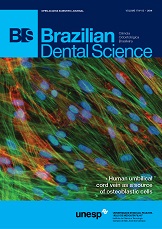Intracanal reinforcement in anterior teeth to prevent fractures
DOI:
https://doi.org/10.14295/bds.2014.v17i3.973Abstract
The fracture of anterior teeth after root canal treatment is a real and multifactorial possibility. This is due to the weakening of the root due to lost of the remaining tooth added to oblique-existing occlusal forces. This fracture in addition to causing a masticatory dysfunction, will also influence the aesthetics of the patient. In prevention, one of the treatments used and widely accepted, is the use of intraradicular. These can be made of metal, carbon fiber, fiberglass and ceramics. The pins of metal and carbon fiber are very efficient but don't favor the aesthetic, as the pins fiberglass and ceramics are very resistant and favor aesthetics. Reinforcing with these biomaterials is beneficial and leads to a favorable prognosis. This study shows a case which the building could have prevented the intracanal fracture of an devitalized upper anterior tooth and makes a brief discussion about the available options for this type of rehabilitation. The use of reinforced glass fiber as reinforcement of the structure of devitalized teeth is indicated for the prevention of dental fractures. Cast ceramic cores are indicated for the insufficient coronary remaining to support the filling material.
Downloads
Downloads
Published
How to Cite
Issue
Section
License
Brazilian Dental Science uses the Creative Commons (CC-BY 4.0) license, thus preserving the integrity of articles in an open access environment. The journal allows the author to retain publishing rights without restrictions.
=================




























